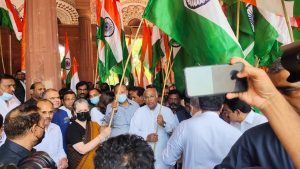The disqualification of Congress leader Rahul Gandhi from the Indian Parliament has visibly brought India’s opposition forces closer, a development that has prompted political commentators to describe it as a turning point in opposition politics against Prime Minister Narendra Modi’s Bharatiya Janata Party (BJP).
With the country due to vote in general elections a year from now, all eyes are on whether and how opposition parties will be able to put up a united fight against the ruling BJP.
The BJP has quite apparently benefited from divisions in the opposition camp in a series of elections since 2014, the latest example being in the Tripura state assembly election. Can that change?
“Rahul Gandhi’s conviction has created a surprising wave of Opposition unity,” Congress parliamentarian Shashi Tharoor told journalists recently.
Indeed, the recent “unity” is surprising. Opposition unity has remained elusive so far because of the competition between the Congress and other opposition parties, such as the Aam Aadmi Party (AAP), Trinamool Congress (TMC), Bharat Rashtra Samithi (BRS), and Samajwadi Party (SP) in various states.
That the leaders of all these parties unequivocally condemned the action against Gandhi and expressed their solidarity is therefore noteworthy.
On March 29, TMC chief and West Bengal Chief Minister Mamata Banerjee called for a “one-is-to-one contest” against the BJP. “This is not a fight for the chair. This is a fight to save the nation. This fight has to be one is to one. This fight has to be BJP versus people,” she said, adding, “The entire opposition has to fight together to throw the BJP out of the country. I will urge all opposition parties because there is not a single one that has not been tortured (by the BJP).”
Banerjee made similar remarks ahead of the 2019 general elections as well. While she favors opposition unity, she favors it under her party’s leadership. Her formula has been that whoever among the opposition parties is the strongest in a constituency should be the candidate against the BJP for that seat. And in Bengal, she thinks her party is the strongest contender against the BJP in all 42 parliamentary constituencies.
Banerjee’s TMC is unwilling to join hands with other parties in Bengal. As a TMC parliamentarian told The Diplomat on condition of anonymity, “There is no possibility of a Left-Congress-TMC joint fight against the BJP in Bengal.”
While the TMC “can never come together with the Communist parties,” which were the TMC’s main rival in Bengal before the BJP replaced the Left, the TMC leadership will “not agree to give the Congress more than two seats” to contest in the state, a deal that would be “very difficult for the state Congress to agree to,” he said, adding that even in those two seats, it was the TMC that performed well in the 2021 state assembly elections.
Therefore, it is not only premature to rejoice over the prospect of opposition unity but, as political trends indicate, the coming months may actually see an even steeper competition between opposition forces, involving the Congress, for the larger share of the opposition space.
Take the case of AAP, which runs governments in the northern states of Delhi and Punjab. The party emerged as a new force in the western state of Gujarat with a 13 percent vote share and five assembly seats in the December 2022 election and entered the Goa assembly with two seats and a 7 percent vote share in February 2022. They are now eyeing the Rajasthan state assembly election scheduled later this year, where, as a third force in the traditional Congress versus BJP bipolar contest in the state, they will pitch to form the new government.
Some parties opposed to the BJP are looking to develop a parallel opposition alliance sans the Congress. In March, leaders of the SP and the Janata Dal–Secular (JD-S) met Banerjee in Kolkata. Banerjee is also coordinating with the BRS.
Which side the JD-S will align with in the general election will depend on the outcome of the assembly elections in Karnataka next month. The state is going to see a triangular contest between the BJP, the Congress, and the JD(S).
Parties that are in regional competition with the Congress want it to cede space to them in the states, which would be dangerous for the grand old party’s own electoral prospects.
Even a few weeks before Gandhi’s disqualification, the Congress was unwilling to stand by other opposition parties. When several opposition leaders wrote to Modi about the harassment of Delhi Deputy Chief Minister Manish Sisodia and other opposition leaders by central investigation agencies, leaders of most parties figured among the signatories. Leaders of the Congress, its close ally the Dravida Munetra Kazhagam, and the Left were conspicuous by their absence in the show of solidarity.
While there is a wave of sympathy for Gandhi subsequent to the government’s action against him, this is not going to derail parallel coalition initiatives for the foreseeable future.
For the Congress to cash in on the injustice that it believes has been done to Gandhi, the party will first have to impress people with its performance in the assembly elections in the four states – Karnataka and Madhya Pradesh, where they are in opposition, and Rajasthan and Chhattisgarh, where they are in power.
As for the non-Congress opposition parties, they would do well to bear in mind that India’s experience with non-Congress, non-BJP “third front” governments (1996-98) has been no so sweet. Therefore, taking on the mighty force of today’s BJP would likely require them to make greater “sacrifices,” i.e., to cede more ground to the Congress than they would otherwise like to. But this all depends heavily on how the Congress fares in the coming assembly elections.
After all, all coalition efforts are matters of bargaining and it’s on the basis of displayed strength that deals can be struck.

































